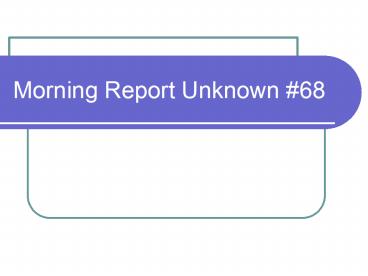Morning Report Unknown - PowerPoint PPT Presentation
1 / 9
Title:
Morning Report Unknown
Description:
Straight leg raises negative, but diminished ROM on hip flexion. No ... C) Restless leg syndrome. D) Deep venous thrombosis. E) Panic ... leg syndrome ... – PowerPoint PPT presentation
Number of Views:95
Avg rating:3.0/5.0
Title: Morning Report Unknown
1
Morning Report Unknown 68
2
- A 70 year old woman is seen for two months of
pain in her legs, which occurs daily. When she
sits at her desk for a period of time, her legs
tighten up. She states she is not very active,
but she walks to loosen up her legs and to
reduce the pain. Lately, she has been feeling
very tired and fatigued during the day, and is
especially jittery at the end of the day. Her
husband states she is always moving about at
night, and thinks she is overly anxious. She
occasionally gets pain in her calf which awakens
her at night. - She has long standing hypertension,
hyperlipidemia and GERD. She takes HCTZ, daily
aspirin, atorvastatin and over the counter
omeprazole. Family history is unremarkable. She
drinks alcohol only occasionally, and does not
smoke. - ROS is positive for occasional low back pain.
3
- Physical exam
- Vital signs 148/90 86 12 37.0 C
- Alert, oriented, appropriate
- Mood / memory normal, no anhedonia
- Cardiac, pulmonary, abdominal exams all normal
- 1 distal pulses
- Completely non-focal neurologic exam
- No rash
- Straight leg raises negative, but diminished ROM
on hip flexion - No calf tenderness
4
- Q1 Which of the following is the most likely
diagnosis in this patient? - Hypokalemia-induced muscle spasm
- B) Lumbar spinal stenosis / pseudoclaudication
- C) Restless leg syndrome
- D) Deep venous thrombosis
- E) Panic / anxiety disorder
- F) Statin-induced myopathy
- G) Peripheral vascular disease
5
- Q2 Of the following, which therapy will be most
beneficial for this patient? - Potassium supplements
- B) Gabapentin
- C) Aortofemoral bypass surgery
- D) Lumbar surgery
- E) NSAIDs
6
- Q1 Which of the following is the most likely
diagnosis in this patient? - Hypokalemia-induced muscle spasm
- B) Lumbar spinal stenosis / pseudoclaudication
- C) Restless leg syndrome
- D) Deep venous thrombosis
- E) Panic / anxiety disorder
- F) Statin-induced myopathy
- G) Peripheral vascular disease
7
- Q2 Of the following, which therapy will be most
beneficial for this patient? - Potassium supplements
- B) Gabapentin
- C) Aortofemoral bypass surgery
- D) Lumbar surgery
- E) NSAIDs
8
Restless leg syndrome
- Spontaneous, continuous leg movements and
paresthesias - Common 5-15 prevalence
- Discomfort at rest, relieved (somewhat) by
movement - Symptoms worse at night, sometimes cause
awakening, pacing the floor to relieve symptoms - Diagnosis typical symptoms plus normal
neurologic exam - Differential dx
- Claudication (abnormal vascular exam)
- Peripheral neuropathy (abnormal neurologic exam)
- Radiculopathy (abnormal neurologic exam,
different symptoms)
9
Restless leg syndrome
- Treatment
- Intermittent RLS Intermittent RLS is defined as
RLS that is troublesome enough when present to
require treatment but that is not sufficiently
frequent to require regular daily medication use.
Treatment options include - Nonpharmacologic therapy
- Iron replacement therapy
- Mental alerting activities
- Avoidance of aggravating factors
- Levodopa
- Dopamine agonists
- Low potency opioids or opioid agonists
- Benzodiazepines or benzodiazepine agonists
- Daily RLS Daily RLS is defined as RLS that is
frequent and troublesome enough to require daily
treatment. Treatment options include - Nonpharmacologic therapy
- Dopamine agonists
- Gabapantin
- Low potency opioids or opioid agonists
OBJECTIVE recognize the clinical presentation of
a patient with restless leg syndrome, and recall
the most appropriate treatment































